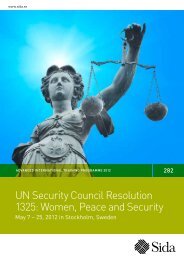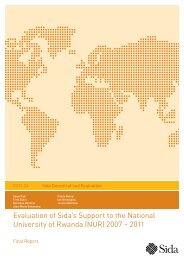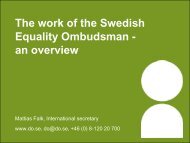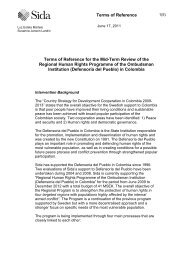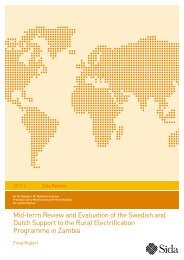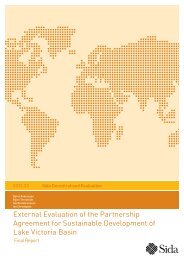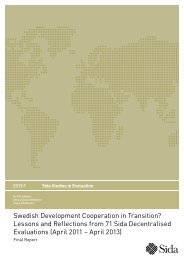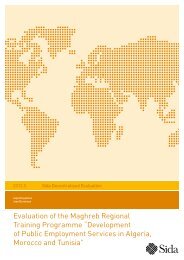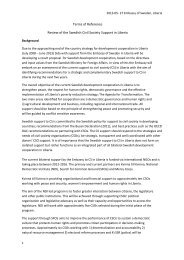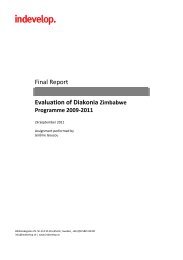Mid-term Review of the Diakonia Strategic Peace Building ... - Sida
Mid-term Review of the Diakonia Strategic Peace Building ... - Sida
Mid-term Review of the Diakonia Strategic Peace Building ... - Sida
Create successful ePaper yourself
Turn your PDF publications into a flip-book with our unique Google optimized e-Paper software.
A N N E X 2 – I N C E P T I O N R E P O R T<br />
In order to be as objective and transparent as possible, a two-step qualitative rating<br />
system will be applied to <strong>the</strong> assessment questions. The evaluator will use <strong>the</strong> same<br />
method as <strong>the</strong> one used for <strong>the</strong> evaluation <strong>of</strong> September 2011. This will allow for a<br />
comparative analysis and for a systematic assessment <strong>of</strong> <strong>the</strong> progress made by <strong>Diakonia</strong><br />
and its partners.<br />
First step: The evaluator will provide a grade for each question (Cf. Box 1) and comments<br />
explaining/justifying <strong>the</strong> reason for <strong>the</strong> grade.<br />
Box 1: The grading system:<br />
D: not performed by <strong>Diakonia</strong> because it is not in <strong>the</strong> organisation’s mandate<br />
C: not done by <strong>Diakonia</strong>, although it could/should have been<br />
B: <strong>Diakonia</strong> attempts to do it, but <strong>the</strong>re is room for improvement<br />
A: <strong>Diakonia</strong> does it well<br />
Second step: Syn<strong>the</strong>sise findings for each chapter.<br />
- The evaluator will count <strong>the</strong> number <strong>of</strong> A, B, C and/or Ds.<br />
- The evaluator will syn<strong>the</strong>sise <strong>the</strong> comments in order to give a global picture <strong>of</strong><br />
<strong>the</strong> relevance <strong>of</strong> <strong>Diakonia</strong>. This results in a rating system that is presented in<br />
Box 2.<br />
Box 2: The rating system<br />
Doubtful relevance: majority <strong>of</strong> D or C<br />
Organisation potentially relevant: majority <strong>of</strong> B<br />
Organisation highly relevant: majority <strong>of</strong> A<br />
Assessing effectiveness<br />
The evaluation will try to address two main issues:<br />
To what extent do <strong>the</strong> activities <strong>of</strong> <strong>Diakonia</strong>’s programme contribute to reaching<br />
its outputs?<br />
To what extent does <strong>the</strong> programme contribute to reaching its objectives (outcomes)?<br />
This part <strong>of</strong> <strong>the</strong> evaluation is going to be challenging, as <strong>Diakonia</strong>’s programme is in<br />
a starting phase. Prior to <strong>the</strong> field visit, <strong>the</strong> evaluator will establish a detailed list <strong>of</strong><br />
activities that have been implemented in order to clarify what is reasonable to be<br />
evaluated.<br />
Assessing efficiency<br />
The efficiency criterion aims at assessing <strong>the</strong> extent to which <strong>the</strong> human (and financial<br />
resources) have been used in an optimal manner. As mentioned in section 1 <strong>of</strong><br />
this report, <strong>the</strong> evaluation will focus on <strong>the</strong> following question: To what extent have<br />
<strong>Diakonia</strong>’s organisational structure, managerial support and coordination mechanisms<br />
effectively supported <strong>the</strong> delivery <strong>of</strong> <strong>the</strong> programme so far?<br />
44



